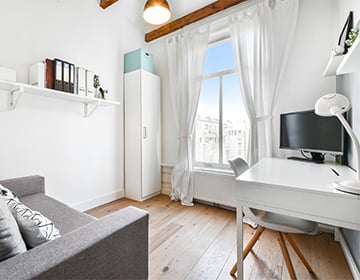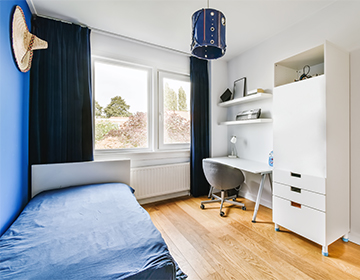- Home
- Blog
- Tips & Advice
- Key Insights for Investing in Student Housing
Key Insights for Investing in Student Housing
Global university enrollment is hitting record highs. Undergraduate enrollment rose 3% in fall 2024, while graduate programs saw even stronger growth. This surge has attracted investor interest in student accommodations as a specialized real estate sector.
The student housing market is booming, with demand consistently outpacing supply. Investors are taking notice of the attractive yields and built-in tenant demand. Now, student housing real estate investments are gaining momentum as a resilient and strategic asset class.
If you're considering student housing as your next investment move, here are the key insights on profitability, market trends, prime locations, and what sets this sector apart from traditional rental properties.
 What is Student Housing Investment?
What is Student Housing Investment?
When students start their higher education, most of them need somewhere to live beyond the family home. Some stay in purpose-built accommodations for their first two years, while others remain in student housing until they complete their education.
Investing in student housing involves purchasing properties specifically designed or adapted to house students. Whether you're building a property or buying one for student accommodation, there are several profitable asset types to consider.
These private student accommodations fall under two main categories: Purpose-Built Student Accommodation (PBSA) or Student HMOs (Houses in Multiple Occupation). Properties can range from individual studio apartments and shared flats to larger dorm-style complexes with communal facilities.
Is Student Housing a Good Investment in 2025?
Since higher education continues expanding globally, investing in student housing offers long-term demand security. Even in 2025, student accommodation remains a compelling investment opportunity for those who understand the market dynamics.
Post-COVID, student housing has bounced back more robustly than many commercial real estate sectors. While the investment landscape has evolved, investor confidence has reached an all-time high. Success in this sector now simply requires more strategic consideration and thorough preparation than it once did.
Why Invest in Student Housing
Key Advantages
Higher Rental Yields: Student housing typically offers higher net yields than standard residential real estate. Its unique leasing model drives these superior returns. Additionally, yields in prime university markets can reach 8-10%, outperforming traditional buy-to-let properties.
Consistent Demand: Ongoing demand for higher education, combined with affordable housing shortages, makes student housing a convenient option for many. Universities aren't going anywhere, creating a reliable tenant pipeline year after year.
Predictable Lease Cycles: This sector benefits from the academic calendar's natural rhythm. University dates and deadlines bring predictable leasing cycles and high pre-booking rates.
 Economic Resilience: Student housing demonstrates remarkable stability even during economic downturns. As university enrollments remain steady or even rise during tough times, student housing investments maintain their income streams. This makes them an attractive passive real estate investment.
Economic Resilience: Student housing demonstrates remarkable stability even during economic downturns. As university enrollments remain steady or even rise during tough times, student housing investments maintain their income streams. This makes them an attractive passive real estate investment.
Main Challenges
Tenant Turnover: Student leases typically run for their academic year, meaning frequent tenant changeover is inevitable.
Seasonal Cycles: Outside of academic months, particularly summer periods, properties may have short-term vacancies. Investors need to develop alternative letting strategies for these months.
Hands-On Management: With multiple young tenants sharing spaces, managing day-to-day operations and maintenance can require more involvement. Professional property management services can be especially helpful, ensuring smooth communication, timely repairs, and a consistently high standard of upkeep.
Different Regulatory Requirements: Student housing often requires HMO (House in Multiple Occupation) licensing. They also need to meet different safety standards than traditional rentals, with specific requirements varying significantly by location.
Student Housing vs Traditional Rentals: How Do They Differ?
Student housing investment returns consistently outperform traditional rentals. However, they differ from conventional models in several important ways.
Traditional buy-to-let properties typically deliver 4-8% yields, whether you're targeting short-term or long-term tenants. Student housing, by contrast, can generate 6-12% yields thanks to the per-room rental model and higher occupancy density.
This higher yield potential comes with seasonal income patterns that differ from traditional rentals. While traditional properties offer year-round stability with predictable monthly income, student housing has concentrated letting periods on academic cycles. However, this cycle also makes turnovers more structured and foreseeable, allowing landlords to plan ahead more effectively.
Additionally, student accommodations require more hands-on management, especially compared to traditional ones.
Key Legal Considerations for Student Housing
- HMO Licensing and Regulations: Most student housing investments fall under HMO (House in Multiple Occupation) regulations, which require specific licensing, enhanced safety measures, and different management protocols compared to single-family rentals.
- Enhanced Safety Standards: Fire safety regulations generally involve additional measures compared to those for traditional rentals.
- Room Size Requirements: Since students typically lease individual rooms within shared properties, there are minimum room size requirements to consider. The specific requirements change depending on the region.
 Key Trends Shaping the Future of Student Housing in 2025
Key Trends Shaping the Future of Student Housing in 2025
Current and Emerging Trends in the Student Housing Market in 2025
Post-COVID university enrollments have bounced back strongly. Both local and international students are returning to campus life, with numbers exceeding pre-pandemic levels. Pre-leasing rates have recovered accordingly.
Student expectations have evolved, too. Many Gen Z students now prioritize privacy, wellness, and community features over basic accommodation. There's a clear shift toward student-focused designs that support academic success, social well-being, and personal safety.
Technology integration is driving this change. Smart features like keyless entry and app-based maintenance requests make operations smoother for both students and landlords.
Sustainability has also become a major differentiator. Today's students actively seek eco-conscious accommodations, reflecting both global environmental awareness and their generation's values.
Effects of Enrollment Trends on Student Housing
Many prestigious universities are reporting steady enrollment growth. Moreover, some are expanding their campuses to accommodate new programs and facilities. This expansion creates an immediate need for more accommodation.
International student numbers are climbing again. Government initiatives and university partnerships are driving demand for premium accommodation from foreign students. Graduate student enrollment is also surging. These older students typically have higher housing budgets and different space requirements than undergraduates. This trend creates diverse housing needs, giving investors the choice between luxury or affordable property investment opportunities.
This surge creates concentrated demand in specific markets before supply can catch up. It opens up opportunities to profit by investing in student housing early in high-growth areas.
Future of the Student Accommodation Sector
Major university cities still face housing shortages despite ongoing development. This supply-demand imbalance keeps occupancy rates high and supports strong rental growth.
The sector's reliable demand is attracting serious institutional money. This increased investment is driving improvements in property standards, management practices, and operational efficiency. Professional management is becoming the norm, making returns more predictable for individual investors.
Looking ahead, sustainability requirements will only intensify. Properties that embrace eco-friendly features, smart technology, and student-centered amenities are positioned to thrive. The sector is evolving toward higher-quality, purpose-built student communities.
 Where to Invest in Student Housing?
Where to Invest in Student Housing?
The best cities for student housing investments are university-dense areas. Particularly, places with established institutions that show consistent enrollment growth. Location really is everything in this sector.
Students expect accommodations within easy reach of their campus, good transport links, and local amenities. Being close to a major university is essential, but there are other crucial factors to consider.
Many students now choose their university city with future job prospects in mind. Cities with strong local job markets and regional growth potential naturally support larger, more stable student populations.
Investors should also look for areas with favorable planning policies and supportive investment frameworks. Whether you're developing new student housing or buying existing properties, understanding local regulations can help your returns.
Promising Markets for 2025
- Málaga, Spain - A growing favorite for European study abroad programs. The city attracts both Spanish students and international learners, with expanding programs specifically designed for foreign students.
- Istanbul and Ankara, Turkey - Both cities are university-dense with robust infrastructure supporting large student populations. Turkey's growing reputation in international education makes these markets particularly attractive.
- Girne, North Cyprus - An emerging destination worth watching. With increasing numbers of international students, this city is developing into a regional education hub with modern facilities and competitive pricing.
Student housing investment opportunities remain compelling in 2025. With post-COVID enrollment hitting new records, this sector offers both stability and growth potential that's hard to find elsewhere.
Recent market shifts and increased professionalization have strengthened investor confidence. Today's student housing market is more transparent, better managed, and more predictable than ever.
For investors seeking higher returns than traditional rentals can provide, student housing presents a proven opportunity. Success simply requires choosing the right location, partnering with experienced property management services, and solid financial and legal planning from the start.




 Key Trends Shaping the Future of Student Housing in 2025
Key Trends Shaping the Future of Student Housing in 2025 Where to Invest in Student Housing?
Where to Invest in Student Housing?






